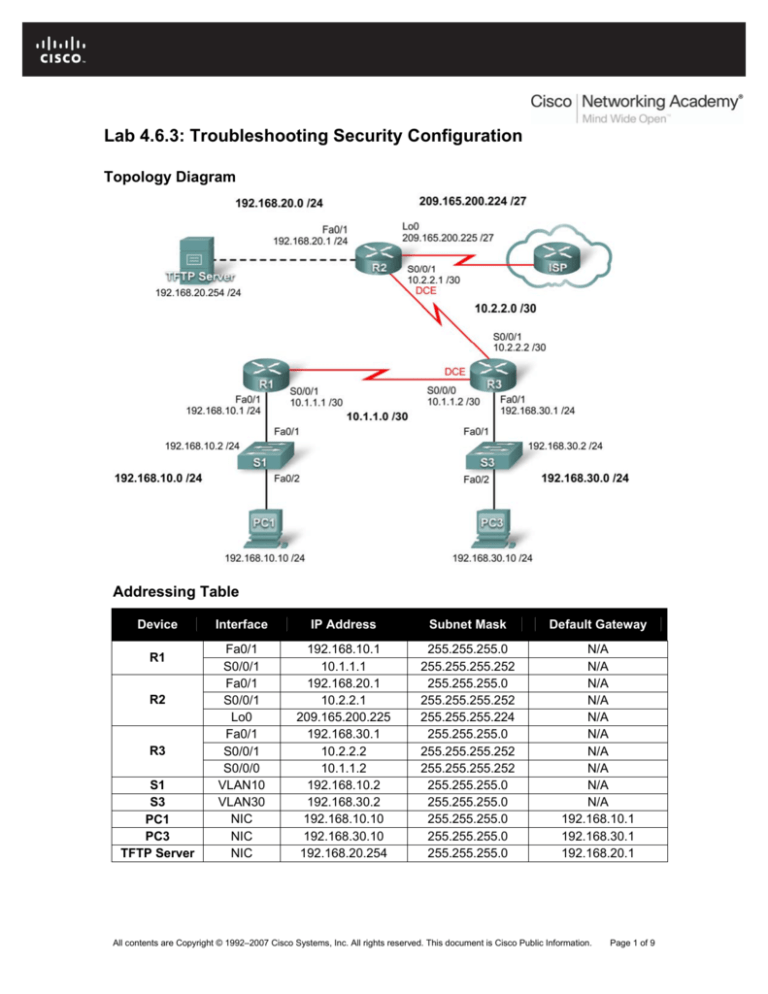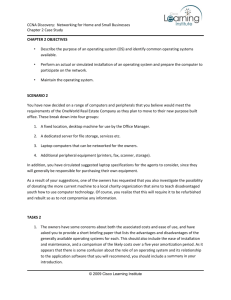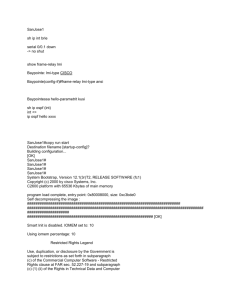
Lab 4.6.3: Troubleshooting Security Configuration
Topology Diagram
Addressing Table
Device
R1
R2
R3
S1
S3
PC1
PC3
TFTP Server
Interface
IP Address
Subnet Mask
Default Gateway
Fa0/1
S0/0/1
Fa0/1
S0/0/1
Lo0
Fa0/1
S0/0/1
S0/0/0
VLAN10
VLAN30
NIC
NIC
NIC
192.168.10.1
10.1.1.1
192.168.20.1
10.2.2.1
209.165.200.225
192.168.30.1
10.2.2.2
10.1.1.2
192.168.10.2
192.168.30.2
192.168.10.10
192.168.30.10
192.168.20.254
255.255.255.0
255.255.255.252
255.255.255.0
255.255.255.252
255.255.255.224
255.255.255.0
255.255.255.252
255.255.255.252
255.255.255.0
255.255.255.0
255.255.255.0
255.255.255.0
255.255.255.0
N/A
N/A
N/A
N/A
N/A
N/A
N/A
N/A
N/A
N/A
192.168.10.1
192.168.30.1
192.168.20.1
All contents are Copyright © 1992–2007 Cisco Systems, Inc. All rights reserved. This document is Cisco Public Information.
Page 1 of 9
CCNA Exploration
Accessing the WAN: : Enterprise Network Security
Lab 4.6.3: Troubleshooting Security Configuration
Learning Objectives
Upon completion of this lab, you will be able to:
•
Cable a network according to the topology diagram
•
Erase the startup configuration and restore all routers to the default state
•
Load routers with supplied scripts
•
Find and correct all network errors
•
Document the corrected network
Scenario
Your company just hired a new network engineer who has created some security issues in the
network with misconfigurations and oversights. Your boss has asked you to correct the errors the
new engineer has made configuring the routers. While correcting the problems, make sure that all
the devices are secure but are still accessible by administrators, and that all networks are
reachable. All routers must be accessible with SDM from PC1. Verify that a device is secure by
using tools such as Telnet and ping. Unauthorized use of these tools should be blocked, but also
ensure that authorized use is permitted. For this lab, do not use login or password protection on
any console lines to prevent accidental lockout. Use ciscoccna for all passwords in this scenario.
Task 1: Load Routers with the Supplied Scripts
Load the following configurations into the devices in the topology.
R1:
no service pad
service timestamps debug datetime msec
service timestamps log datetime msec
service password-encryption
!
hostname R1
!
boot-start-marker
boot-end-marker
!
security authentication failure rate 10 log
security passwords min-length 6
enable secret ciscoccna
!
aaa new-model
!
aaa authentication login LOCAL_AUTH local
!
aaa session-id common
!
resource policy
!
mmi polling-interval 60
no mmi auto-configure
no mmi pvc
mmi snmp-timeout 180
ip subnet-zero
no ip source-route
no ip gratuitous-arps
All contents are Copyright © 1992–2007 Cisco Systems, Inc. All rights reserved. This document is Cisco Public Information.
Page 2 of 9
CCNA Exploration
Accessing the WAN: : Enterprise Network Security
Lab 4.6.3: Troubleshooting Security Configuration
ip cef
!
no ip dhcp use vrf connected
!
no ip bootp server
!
key chain RIP_KEY
key 1
key-string cisco
username ccna password ciscoccna
!
interface FastEthernet0/0
no ip address
no ip redirects
no ip unreachables
no ip proxy-arp
no shutdown
duplex auto
speed auto
!
interface FastEthernet0/1
ip address 192.168.10.1 255.255.255.0
no ip redirects
no ip unreachables
no ip proxy-arp
duplex auto
speed auto
no shutdown
!
!
interface Serial0/0/0
no ip address
no ip redirects
no ip unreachables
no ip proxy-arp
no shutdown
no fair-queue
clockrate 125000
!
interface Serial0/0/1
ip address 10.1.1.1 255.255.255.252
no ip redirects
no ip unreachables
no ip proxy-arp
no shutdown
!
interface Serial0/1/0
no ip address
no ip redirects
no ip unreachables
no ip proxy-arp
no shutdown
clockrate 2000000
!
interface Serial0/1/1
no ip address
All contents are Copyright © 1992–2007 Cisco Systems, Inc. All rights reserved. This document is Cisco Public Information.
Page 3 of 9
CCNA Exploration
Accessing the WAN: : Enterprise Network Security
Lab 4.6.3: Troubleshooting Security Configuration
no ip redirects
no ip unreachables
no ip proxy-arp
no shutdown
!
router rip
version 2
passive-interface default
no passive-interface Serial0/0/0
network 10.0.0.0
network 192.168.10.0
no auto-summary
!
ip classless
!
no ip http server
!
logging 192.168.10.150
no cdp run
!
line con 0
exec-timeout 5 0
logging synchronous
transport output telnet
line aux 0
exec-timeout 15 0
logging synchronous
login authentication local_auth
transport output telnet
line vty 0 4
exec-timeout 5 0
logging synchronous
login authentication local_auth
!
end
R2:
no service pad
service timestamps debug datetime msec
service timestamps log datetime msec
!
hostname R2
!
security authentication failure rate 10 log
security passwords min-length 6
!
aaa new-model
!
aaa authentication login local_auth local
!
aaa session-id common
!
resource policy
!
mmi polling-interval 60
no mmi auto-configure
All contents are Copyright © 1992–2007 Cisco Systems, Inc. All rights reserved. This document is Cisco Public Information.
Page 4 of 9
CCNA Exploration
Accessing the WAN: : Enterprise Network Security
Lab 4.6.3: Troubleshooting Security Configuration
no mmi pvc
mmi snmp-timeout 180
no ip source-route
no ip gratuitous-arps
ip cef
!
no ip dhcp use vrf connected
!
no ip bootp server
!
!
username ccna password ciscoccna
!
!
interface FastEthernet0/0
no ip address
no ip redirects
no ip unreachables
no ip proxy-arp
no ip directed-broadcast
shutdown
duplex auto
speed auto
!
interface FastEthernet0/1
ip address 192.168.20.1 255.255.255.0
no ip redirects
no ip unreachables
no ip proxy-arp
no ip directed-broadcast
duplex auto
speed auto
no shutdown
!
interface Serial0/0/0
no ip address
no ip redirects
no ip unreachables
no ip proxy-arp
no ip directed-broadcast
shutdown
no fair-queue
!
interface Serial0/0/1
ip address 10.2.2.1 255.255.255.252
no ip redirects
no ip unreachables
no ip proxy-arp
no ip directed-broadcast
ip rip authentication mode md5
ip rip authentication key-chain RIP_KEY
clockrate 128000
no shutdown
!
interface Serial0/1/0
ip address 209.165.200.224 255.255.255.224
All contents are Copyright © 1992–2007 Cisco Systems, Inc. All rights reserved. This document is Cisco Public Information.
Page 5 of 9
CCNA Exploration
Accessing the WAN: : Enterprise Network Security
Lab 4.6.3: Troubleshooting Security Configuration
no ip redirects
no ip unreachables
no ip proxy-arp
no ip directed-broadcast
no shutdown
!
interface Serial0/1/1
no ip address
no ip redirects
no ip unreachables
no ip proxy-arp
no ip directed-broadcast
shutdown
clockrate 2000000
!
router rip
version 2
no passive-interface Serial0/0/1
network 10.0.0.0
network 192.168.20.0
no auto-summary
!
ip classless
!
no ip http server
!
logging trap debugging
logging 192.168.10.150
!
line con 0
exec-timeout 5 0
logging synchronous
transport output telnet
line aux 0
exec-timeout 15 0
logging synchronous
login authentication local_auth
transport output telnet
line vty 0 4
exec-timeout 0 0
logging synchronous
login authentication local_auth
transport input telnet
!
end
R3:
no service pad
service timestamps debug datetime msec
service timestamps log datetime msec
service password-encryption
!
hostname R3
!
boot-start-marker
boot-end-marker
All contents are Copyright © 1992–2007 Cisco Systems, Inc. All rights reserved. This document is Cisco Public Information.
Page 6 of 9
CCNA Exploration
Accessing the WAN: : Enterprise Network Security
Lab 4.6.3: Troubleshooting Security Configuration
!
security authentication failure rate 10 log
security passwords min-length 6
enable secret ciscoccna
!
aaa new-model
!
aaa authentication login local_auth local
!
aaa session-id common
!
resource policy
!
mmi polling-interval 60
no mmi auto-configure
no mmi pvc
mmi snmp-timeout 180
ip subnet-zero
no ip source-route
no ip gratuitous-arps
ip cef
!
!
no ip dhcp use vrf connected
!
no ip bootp server
!
key chain RIP_KEY
key 1
key-string Cisco
!
interface FastEthernet0/0
no ip address
no ip redirects
no ip proxy-arp
no ip directed-broadcast
duplex auto
speed auto
shutdown
!
interface FastEthernet0/1
ip address 192.168.30.1 255.255.255.0
no ip redirects
no ip unreachables
no ip proxy-arp
no ip directed-broadcast
no shutdown
duplex auto
speed auto
!
interface Serial0/0/0
ip address 10.1.1.2 255.255.255.252
no ip redirects
no ip unreachables
no ip proxy-arp
no ip directed-broadcast
All contents are Copyright © 1992–2007 Cisco Systems, Inc. All rights reserved. This document is Cisco Public Information.
Page 7 of 9
CCNA Exploration
Accessing the WAN: : Enterprise Network Security
Lab 4.6.3: Troubleshooting Security Configuration
clockrate 125000
!
interface Serial0/0/1
ip address 10.2.2.2 255.255.255.252
no ip redirects
no ip unreachables
no ip proxy-arp
no ip directed-broadcast
!
router rip
version 2
passive-interface default
passive-interface Serial0/0/0
passive-interface Serial0/0/1
network 10.0.0.0
network 192.168.30.0
no auto-summary
!
ip classless
!
no ip http server
!
logging trap debugging
logging 192.168.10.150
no cdp run
!
control-plane
!
line con 0
exec-timeout 5 0
logging synchronous
transport output telnet
line aux 0
exec-timeout 15 0
logging synchronous
login authentication local_auth
transport output telnet
line vty 0 4
exec-timeout 15 0
logging synchronous
login authentication local_auth
transport input telnet
!
end
Task 2: Find and Correct all Network Errors
Using standard troubleshooting methods, find, document, and correct each error.
Note: When troubleshooting a production network that is not working, many very small mistakes
can prevent everything from working correctly. The first item to check is the spelling and case of
all passwords, keychain names and keys, and authentication list names. It is often a mismatch in
case or spelling that causes total failure. The best practice is to start with the most basic and work
upward. First ask whether all the names and keys match up. Next, if the configuration uses a list
or keychain and so on, check if the item referenced actually exists and is the same on all devices.
Configuring something once on one device and then copying and pasting into the other device is
All contents are Copyright © 1992–2007 Cisco Systems, Inc. All rights reserved. This document is Cisco Public Information.
Page 8 of 9
CCNA Exploration
Accessing the WAN: : Enterprise Network Security
Lab 4.6.3: Troubleshooting Security Configuration
the best way to ensure that the configuration is exactly the same. Next, when thinking about
disabling or restricting services, ask what the services are used for and if they are needed. Also
ask what information the router should be sending out. Who should and should not receive that
information. Finally, ask what the services enable the users to do, and do you want them to be
able to do that. Generally, if you can think of a way that a service can be abused, you should take
steps to prevent that.
Task 3: Document the Corrected Network
Task 4: Clean Up
Erase the configurations and reload the routers. Disconnect and store the cabling. For PC hosts
that are normally connected to other networks (such as the school LAN or to the Internet),
reconnect the appropriate cabling and restore the TCP/IP settings.
All contents are Copyright © 1992–2007 Cisco Systems, Inc. All rights reserved. This document is Cisco Public Information.
Page 9 of 9







